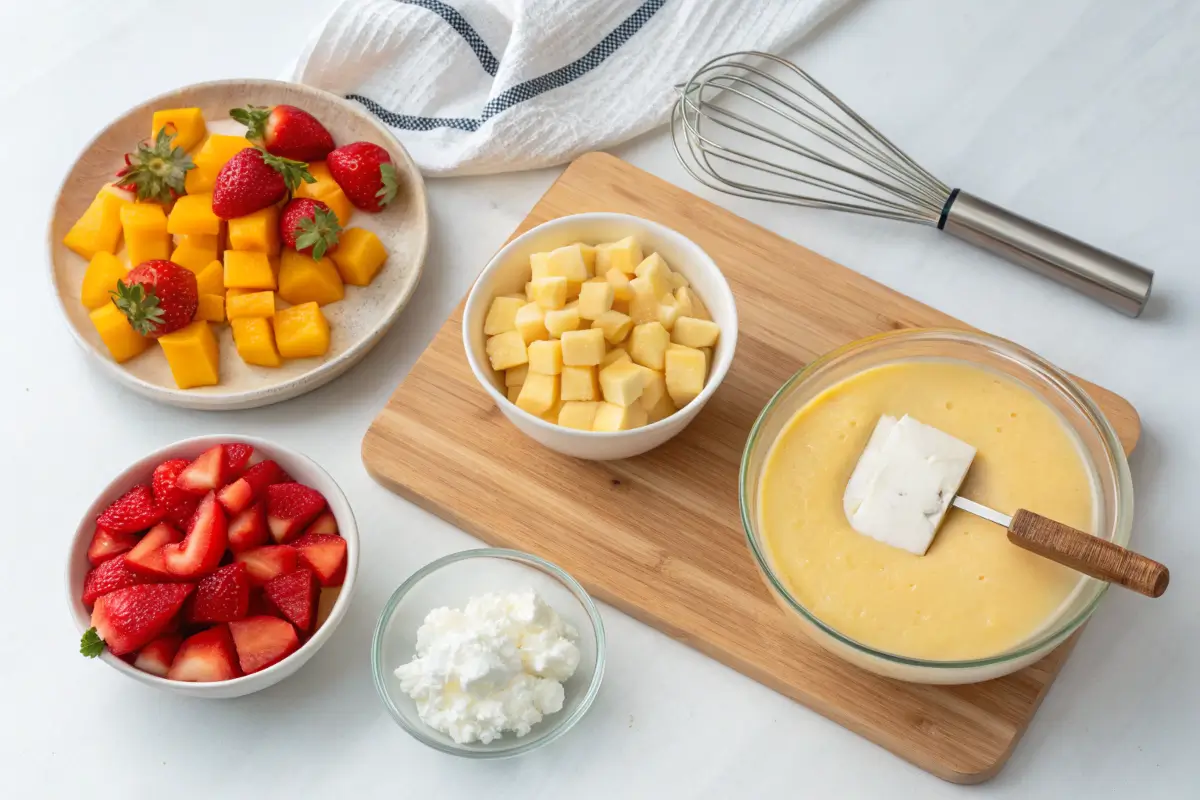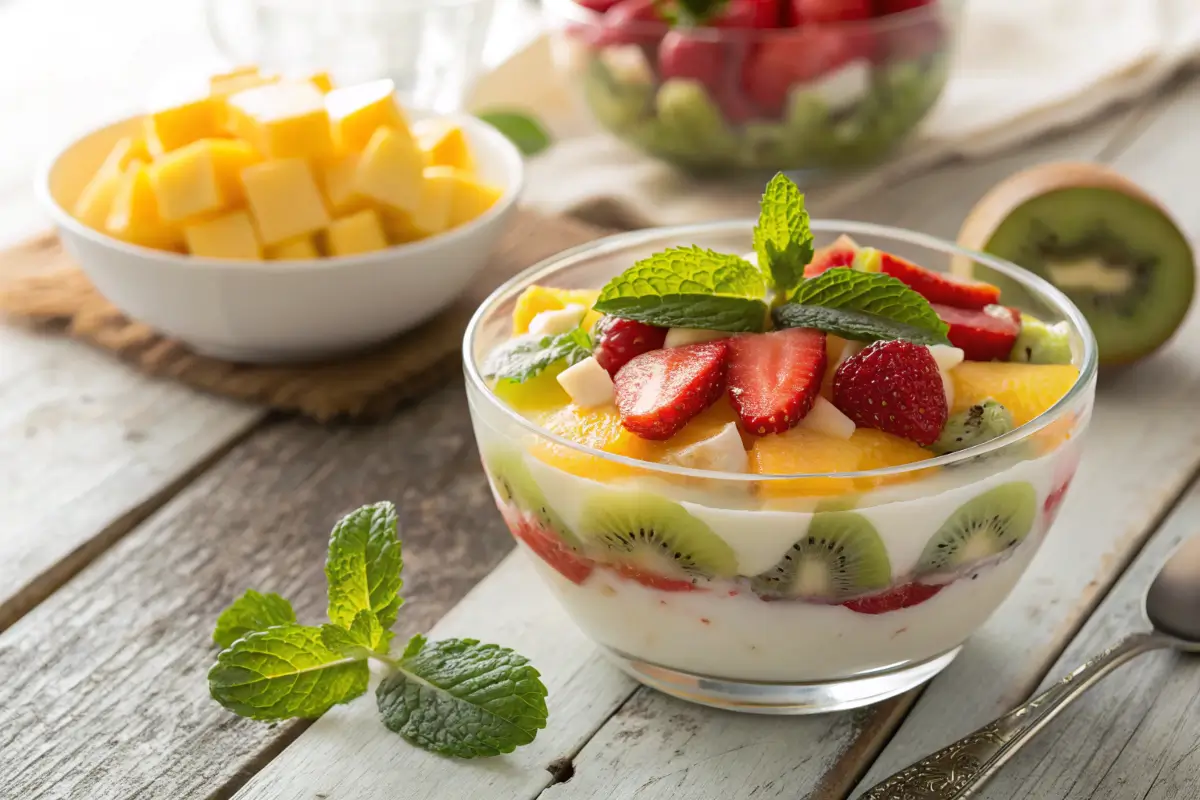If you’ve ever craved a refreshing dessert that’s easy to make yet bursting with tropical flavors, this nata fruit pudding recipe is perfect for you. Combining the chewy goodness of nata de coco, the sweetness of fresh fruits, and the creamy texture of pudding, it’s ideal for warm summer days or as a showstopper at your next gathering. This guide will walk you through everything you need to know, from ingredients and preparation tips to creative serving ideas and variations. Let’s dive in!
Introduction to Nata Fruit Pudding
What is Nata Fruit Pudding?
Nata fruit pudding is a vibrant dessert featuring nata de coco—a chewy, jelly-like product made from fermented coconut water. It’s paired with fresh, juicy fruits and a rich pudding base, creating a harmony of flavors and textures. This dessert is not only delicious but also versatile, allowing you to customize it with your favorite fruits and flavors.
Key Ingredients in Nata Fruit Pudding
The star of this dish is nata de coco, which adds a unique chewiness that complements the creamy pudding and refreshing fruits. Typical ingredients include mangoes, kiwis, strawberries, or peaches, chosen for their bright flavors and colors. To bind it all together, a silky pudding made from condensed milk or a dairy-free alternative serves as the base. Optional add-ons like chia seeds or crushed nuts can add a fun crunch.
Why This Dessert is Popular in Tropical Regions
This pudding is especially loved in tropical climates because it’s light, cooling, and made from ingredients readily available in these regions. The combination of sweet fruits and hydrating nata de coco is perfect for beating the heat. Its ease of preparation also makes it a go-to dessert for family gatherings and celebrations, especially in countries like the Philippines, where nata de coco is a staple ingredient.
Ingredients for Nata Fruit Pudding
Core Ingredients: Nata de Coco, Fresh Fruits, and Cream
To make a delightful nata fruit pudding recipe, you’ll need a handful of basic ingredients. The key component, nata de coco, adds a chewy texture that contrasts beautifully with the creamy pudding base. For the fruits, options like mangoes, kiwis, strawberries, and peaches work best as they bring vibrant colors and natural sweetness.
The creamy pudding base is often made from a mix of condensed milk, evaporated milk, and cream, but you can substitute these with plant-based options if you’re going for a dairy-free twist. Don’t forget a bit of gelatin or agar-agar to help set the pudding to the right consistency.
Optional Add-ons for Flavor and Texture
To make your pudding even more special, consider adding fun ingredients like chia seeds, crushed graham crackers, or a drizzle of honey. These add-ons provide unique textures and an extra layer of flavor that elevates the dish. For a tropical touch, shredded coconut or a splash of vanilla essence can work wonders.
Where to Source Fresh Ingredients
Fresh ingredients are essential for this dessert to shine. Look for seasonal fruits at your local farmer’s market to ensure peak ripeness and flavor. Nata de coco is often found in the international aisle of grocery stores or Asian markets. If you prefer convenience, many online retailers stock nata de coco as well.
Step-by-Step Recipe Guide
Preparing the Fruits and Nata de Coco

Begin by washing and cutting your chosen fruits into bite-sized pieces. Aim for uniform sizes to ensure an even distribution of flavors in every bite. Drain the nata de coco thoroughly to remove excess syrup, as this can dilute the pudding base. Pat it dry with a paper towel to get the best texture.
Crafting the Pudding Base
To create the creamy base, combine condensed milk, evaporated milk, and cream in a saucepan. Heat gently over low heat, stirring continuously to prevent scorching. If you’re using gelatin or agar-agar, dissolve it in warm water before adding it to the mixture. For a dairy-free alternative, coconut milk and almond cream work beautifully. Let the mixture cool to room temperature before assembling the dessert.
Assembling the Layers of the Dessert
Start by spreading a layer of pudding base at the bottom of your serving dish. Add a generous handful of nata de coco and your choice of fruits, then pour another layer of pudding over the top. Repeat until all ingredients are used, ensuring the final layer is the pudding for a smooth finish.
Tips for Achieving Perfect Texture and Flavor
Refrigerate the dessert for at least 4 hours or overnight to let the flavors meld together. To prevent fruits from browning, toss them in a bit of lemon juice before layering. Use a clear glass dish for presentation—it showcases the colorful layers and makes the dessert even more tempting.
Variations of Nata Fruit Pudding
Vegan-Friendly Nata Fruit Pudding Recipe
For those following a vegan lifestyle, you can easily modify the nata fruit pudding recipe without compromising taste or texture. Replace dairy-based ingredients like condensed milk and cream with plant-based alternatives such as coconut cream or almond milk. Use agar-agar, a seaweed-based gelatin substitute, to achieve the perfect pudding consistency. The result? A luscious, cruelty-free dessert that’s just as delightful as the original!
Using Tropical Fruits Like Mango, Kiwi, and Pineapple
One of the best things about nata fruit pudding is how adaptable it is to different fruits. Incorporating tropical favorites like mango, kiwi, and pineapple adds a burst of vibrant flavor. Mango brings sweetness, kiwi adds a tangy kick, and pineapple delivers a juicy tartness. The interplay of these fruits with the chewy nata de coco and creamy pudding creates a well-rounded dessert experience.
Low-Sugar and Healthier Alternatives
For a healthier twist, opt for low-sugar condensed milk or replace sugar altogether with natural sweeteners like honey or stevia. Fruits like berries or green apples can be used to introduce a natural tartness that balances the dish. You can also experiment with adding Greek yogurt to the pudding base for a boost of protein and probiotics. This variation is perfect for guilt-free indulgence.
Serving and Presentation Ideas
Creative Ways to Serve Nata Fruit Pudding

Presentation is everything when it comes to desserts. Serve your nata fruit pudding recipe in clear glass bowls or mason jars to highlight the vibrant fruit layers. Alternatively, use mini trifle dishes for an individual portion that’s perfect for parties or gatherings. Garnish with fresh mint leaves or edible flowers for an elegant touch.
Garnishing Tips for an Aesthetic Appeal
A well-garnished dessert is always more appealing. Sprinkle shredded coconut, drizzle caramel sauce, or add a dusting of powdered sugar on top of the pudding before serving. Fresh fruit slices placed strategically can add pops of color and enhance the overall look of your dish.
Ideal Pairings: Beverages and Other Desserts
Pair this tropical delight with refreshing drinks like iced tea or coconut water for a cohesive summer vibe. For a more indulgent pairing, serve it alongside a scoop of vanilla ice cream or a slice of pound cake. These combinations elevate the dessert and make it a centerpiece for any meal.
Frequently Asked Questions (FAQs)
Can I Use Canned Fruits for This Recipe?
Yes, canned fruits work well in the nata fruit pudding recipe, especially when fresh options aren’t available. Drain the syrup completely to avoid making the pudding too watery. Canned peaches, pineapples, and fruit cocktail mixes are excellent choices for convenience without sacrificing flavor.
How Long Can I Store Nata Fruit Pudding?
When properly stored in an airtight container in the refrigerator, nata fruit pudding can last up to three days. To maintain its freshness, keep it chilled and avoid leaving it at room temperature for extended periods. Adding a layer of plastic wrap directly on the pudding’s surface can also help prevent it from forming a skin.
What Is the Best Substitute for Nata de Coco?
If you can’t find nata de coco, you can use coconut jelly or aloe vera cubes as a substitute. While the texture may differ slightly, these alternatives still provide a similar chewy element. Tapioca pearls are another option, particularly for those who enjoy bubble tea-inspired desserts.
Is It Possible to Make This Dessert Dairy-Free?
Absolutely! Swap the condensed milk and cream for coconut cream and almond or soy milk to make a dairy-free version of this dessert. Using agar-agar instead of gelatin ensures that the recipe remains entirely plant-based while still achieving a smooth and creamy texture.
Benefits of Nata Fruit Pudding
Nutritional Value of Nata de Coco and Fruits
Nata de coco is not just delicious—it’s low in calories and high in dietary fiber, making it a guilt-free ingredient in this dessert. The addition of fresh fruits like mangoes, strawberries, and kiwis provides essential vitamins and antioxidants that boost overall health.
Why It’s a Perfect Dessert for Summer
This dessert is light, refreshing, and packed with hydrating ingredients, making it ideal for hot summer days. The combination of creamy pudding, juicy fruits, and chewy nata de coco offers a cooling effect that’s hard to beat. Plus, it’s easy to prepare ahead of time, which is perfect for summer gatherings.
Serving Nata Fruit Pudding for Special Occasions
The nata fruit pudding recipe isn’t just for casual days—it’s also an excellent choice for special occasions. Whether it’s a birthday, picnic, or family reunion, this vibrant dessert is sure to impress your guests. Its colorful presentation and customizable ingredients make it a crowd-pleaser at any event.
Conclusion and Final Tips
Why Nata Fruit Pudding Should Be Your Next Go-To Dessert
The nata fruit pudding recipe stands out as a simple yet indulgent dessert that’s perfect for any occasion. Its combination of fresh fruits, chewy nata de coco, and creamy pudding makes it a crowd-pleaser for all ages. Whether you’re hosting a party or just treating yourself, this tropical delight is sure to impress. Plus, it’s highly customizable, so you can tailor it to your preferences or dietary needs.
A Quick Recap of the Recipe
Making this pudding is as easy as it is rewarding. Start with fresh fruits, a creamy pudding base, and nata de coco. Layer them in a dish, let it chill, and enjoy! From vegan options to healthier variations, this dessert offers endless possibilities. With its vibrant presentation and refreshing taste, the nata fruit pudding recipe is one you’ll come back to time and time again.
Frequently Asked Questions and Related Tips
Why Should I Choose This Recipe?
This nata fruit pudding recipe is not only delicious but also flexible, easy to prepare, and nutritious. It’s a win-win for both your taste buds and your health.
Can I Substitute Other Ingredients?
Yes, substituting fruits, gelatin, or even milk can lead to exciting variations tailored to your preferences.
How Do I Prevent the Pudding from Becoming Too Runny?
To avoid a watery texture, ensure you drain the nata de coco and fruits thoroughly before adding them to the pudding. Using the right amount of thickener, such as gelatin or agar-agar, also helps achieve the perfect consistency.
Can I Prepare This Dessert in Advance?
Absolutely! The nata fruit pudding recipe is ideal for preparing ahead of time. You can assemble it a day before and refrigerate it overnight. This not only saves time but also allows the flavors to meld beautifully.

